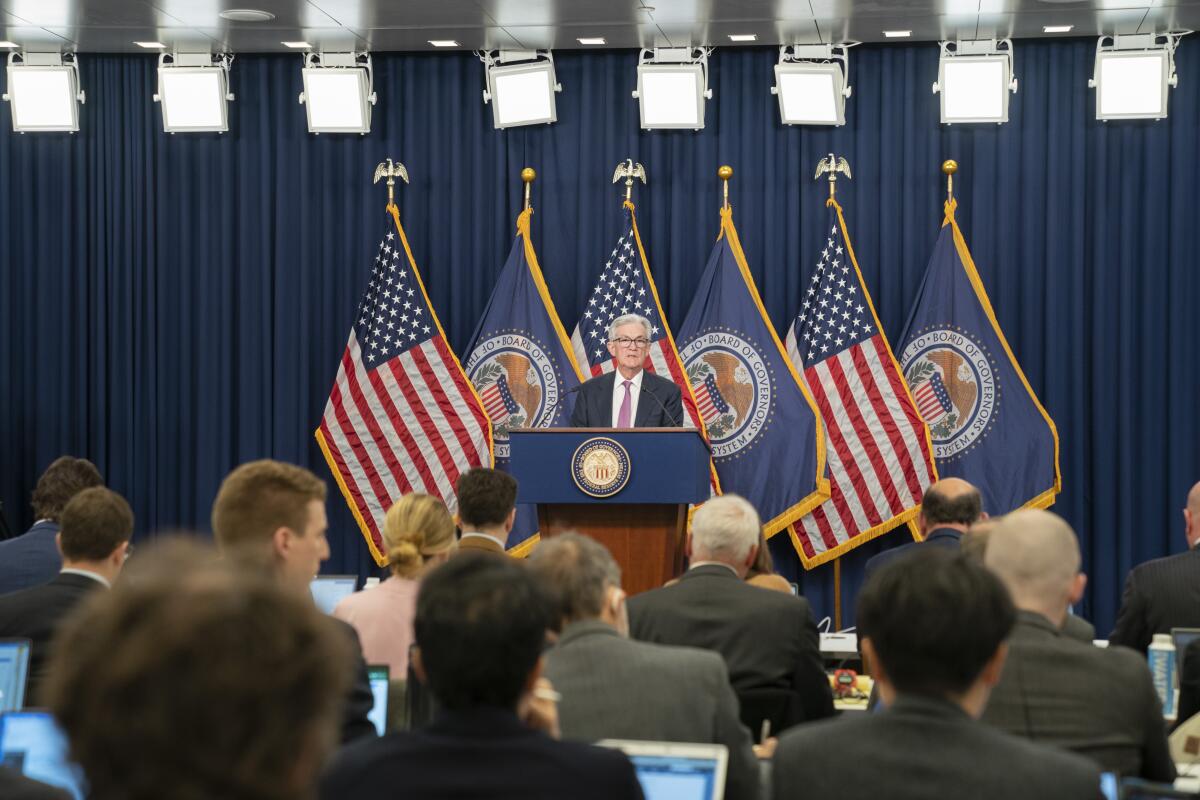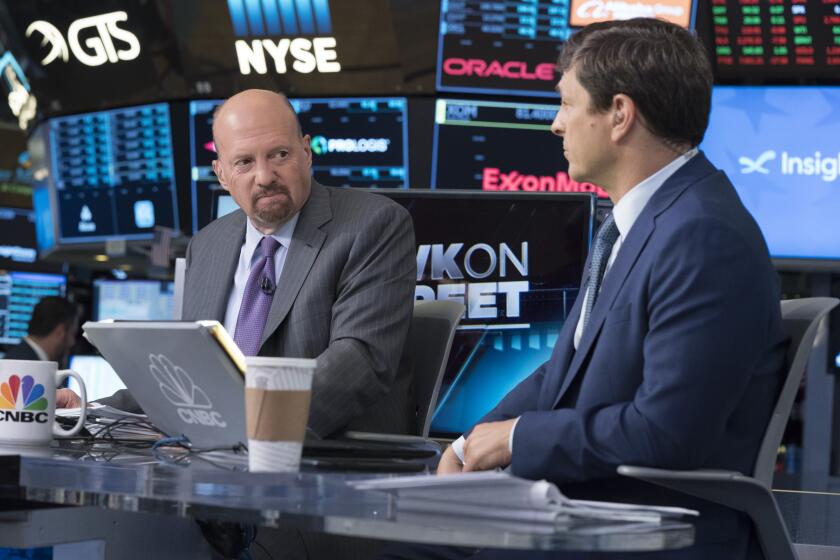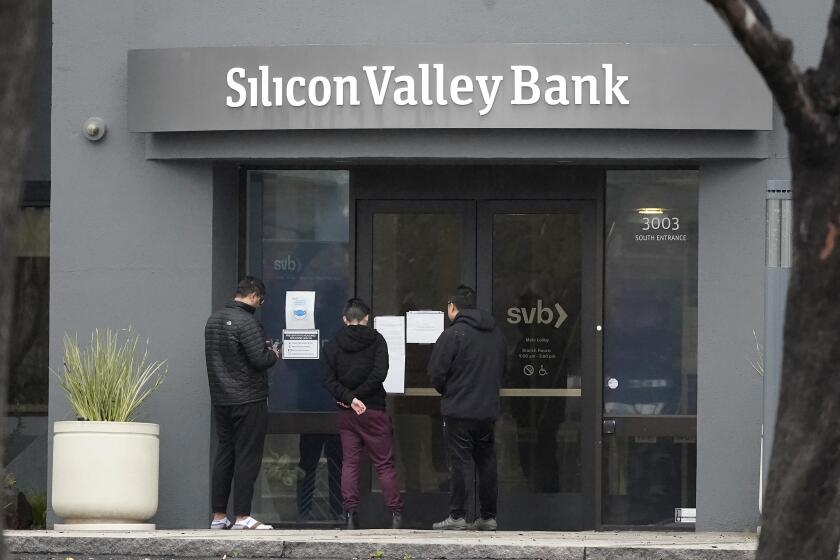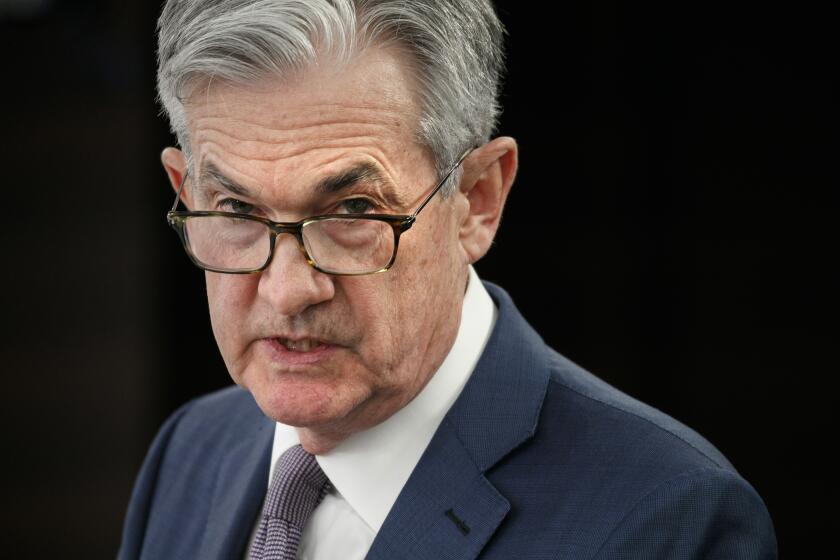Column: How Trump’s frenzy of deregulation killed Silicon Valley Bank

- Share via
Late in 2018, two Trump-appointed banking regulators, Federal Reserve Vice Chair Randal Quarles and FDIC Chair Jelena McWilliams, went on a nationwide tour to meet with regional bank examiners.
If you’re looking for the roots of the banking crisis that took down Silicon Valley Bank and has rattled the entire financial sector for weeks, that’s as good a place to start as any.
The officials’ message to the examiners was: Back off.
The most senior leadership of the Federal Reserve was...telling the bankers to stand up to the supervisors, and telling the supervisors, ‘Don’t think we’ve got your back.’
— Dennis Kelleher, Better Markets
Banks had been bristling for years over what they saw as overly intrusive supervision by the federal agents. That included government examiners, known as supervisors, going over the heads of executives and meeting directly with boards of directors to warn them about risky behavior.
Quarles, the Fed’s vice chair for supervision, had served several stints at the Treasury Department under Republican presidents but came to his latest post directly from the private equity business. He was especially candid about making supervision more bank-friendly.
Get the latest from Michael Hiltzik
Commentary on economics and more from a Pulitzer Prize winner.
You may occasionally receive promotional content from the Los Angeles Times.
In November 2017, only a month after taking office, he said at a conference of big banks that “changing the tenor of supervision will probably actually be the biggest part of what it is that I do,” adding that he “perceived quite an openness in the deep state at the Fed to taking a fresh look.”
In the aftermath of SVB’s March 10 collapse, fingers have been pointing everywhere. The Fed and other regulators condemn the bank’s executives; Fed Vice Chair Michael Barr, in testimony before the Senate Banking Committee on Tuesday, called the bank’s failure “a textbook case of mismanagement.”
Lawmakers point their fingers at the Fed; as Sen. Tim Scott (R-S.C.), ranking member of the committee, inveighed, the warning signs of SVB’s failure were “clear as a bell.” He condemned the Fed, bizarrely, for paying more attention to the implications of climate change than bank supervision.
Others have pointed to the 2018 rollback of regulations imposed by the 2010 Dodd-Frank banking reform act, softening the rules for mid-sized banks such as SVB. Dodd-Frank was written to avert a repeat of the 2008 banking crisis that almost wrecked the U.S. economy. The 2018 amendments set the industry up for a new crisis.
What everyone seems to be missing is the overall deregulatory atmosphere of the Trump administration. At the Fed, the urge to lighten oversight came from the top, in the person of Fed Chairman Jerome Powell, who had been placed on the Fed Board by Barack Obama but elevated to the chairmanship by Donald Trump.
Silicon Valley Bank telegraphed that its securities holdings were underwater. Why didn’t the regulators act sooner?
Powell has tried to portray himself as something of an innocent bystander in the SVB crisis. But he oversaw the deregulatory steps that produced it.
“One of the senators said the bank supervisors were ‘asleep at the wheel,’” observes Dennis Kelleher, chief executive of Better Markets, a Washington-based financial watchdog. “No, Powell and Quarles had the wheel, and the supervisors were in the back seat and were being told to shut up like kids on a vacation.”
It’s useful to revisit that era. Trump and his acolytes had the knives out for any financial regulation that burdened the banks. Trump installed his budget director Mick Mulvaney at the head of the Consumer Financial Protection Bureau, which Congress had created at the instigation of Sen. Elizabeth Warren (D-Mass.) to ride herd on abusive banking practices.
“I am the acting director of the CFPB,” Mulvaney crowed to a banking conference, “something that’s apparently keeping Elizabeth Warren up late at night, which doesn’t bother me at all.”
Comptroller of the Currency Joseph Otting, another Trump appointee, moved to soften rules on money-laundering and bank investments, while calling banks his agency’s “customers.” Of course, the customers of the Office of the Comptroller of the Currency (OCC) are the public; banks are its targets.
“From the start of the Trump administration, deregulating finance was at the top of the agenda,” notes a fact sheet compiled by Better Markets. Trump appointed deregulators at the White House, Fed, FDIC, OCC and elsewhere in the executive branch.
Their actions were seldom justified with painstaking analyses of their impact. Instead, they were built around “vacuous words and phrases” — regulations were “tailored,” “streamlined,” “right-sizing,” and made “fair.”
The deregulatory changes weren’t unanimous at the Fed or FDIC. Fed Gov. Lael Brainard, who was appointed in 2014 by Obama, was a consistent dissenter. (Brainard left the Fed in February to become head of President Biden’s National Economic Council.)
Martin J. Gruenberg, who was originally appointed to the FDIC board in 2005 by George W. Bush, dissented at least 15 times between 2018 and 2020 from efforts to soften regulations. Gruenberg is currently the FDIC chairman.
Although Quarles was the front man for deregulation at the Fed, “Chair Powell not only voted for every single deregulation rule Quarles proposed,” Better Markets’ fact sheet states, “but he also enthusiastically supported that deregulation in speeches, Q&As, and in congressional testimony.” Indeed, Powell launched the Fed’s deregulatory campaign even before Quarles was sworn in on Nov. 6, 2017.
Powell proposed one key initiative in August 2017. This concerned how banking supervisors reviewed bank practices and communicated their findings. Chiefly at issue were notices of “Matters Requiring Attention” (MRA) and “Matters Requiring Immediate Attention” (MRIA).
Demands by the tech industry’s most vocal libertarians for a government bailout of Silicon Valley call to mind the old saw: The goal in business to privatize profits and socialize losses.
The latter, according to Fed rules, were issues that “have the potential to pose significant risk to the safety and soundness” of the bank, could cause “significant consumer harm,” were repeat complaints, or that deviated from the law. MRA notices involved problems that needed correcting, but only over time.
Prior to Powell’s initiative, both notices typically were delivered to a bank’s board of directors, which was thus tasked with taking them up with management. Henceforth, the notices only needed to be sent to “senior management,” with board notification only if executives consistently failed to act.
Powell’s rule change cut boards out of the loop. This had a subtle but important effect, for it eliminated the only internal layer of oversight of management activities. Just as important, it eliminated a crucial avenue of contact between supervisors and boards.
The change may have played an especially important role in the collapse of SVB, for MRAs and MRIAs began piling up at the bank starting at least a year before the end. Whether management alerted the SVB board to the accumulating pile isn’t known (MRAs and MRIAs are generally kept confidential), but the board no longer had to know.
Just as a reminder: SVB’s fundamental problem was that it had a huge number of skittish depositors, most of whose money was uninsured by the FDIC and could be withdrawn on demand, and had invested those deposits in treasuries and bonds that were generally safe but wouldn’t mature in less than 10 years. After a series of interest rate hikes, the bonds were showing immense losses on paper. When the depositors pulled their money — to the tune of $42 billion on March 9 — the bank couldn’t liquidate its bond portfolio in a way that wouldn’t convert its paper losses to real losses, so it ran out of money to pay the depositors.
At least some of the MRA and MRIA notices concerned the mismatch between SVB’s illiquid bond portfolio and its potentially excitable deposit base, according to testimony by Barr.
Another initiative by the Fed, FDIC, OCC and other federal regulators also cut the legs out from under the supervisors. This was a joint notice stating that “supervisory guidance” — the process used by examiners to force banks to rein in risky activities — couldn’t be used unless they could identify a specific law or regulation that the activities violated.
That opened the process to almost infinite legal dickering. “It sent the message that the balance of power had changed,” Kelleher told me.
“The most senior leadership of the Federal Reserve was now coming down on the side of the banks, not the supervisors. They were telling the bankers to stand up to the supervisors, and telling the supervisors, ‘Don’t think we’ve got your back.’”
One other initiative the banks successfully lobbied for was a rollback of the “Volcker Rule,” a provision of the Dodd-Frank law that limited their risky investments in hedge funds, private equity and venture funds. The Fed and its fellow regulators removed venture funds from that list at the specific request of Silicon Valley Bank, which rapidly doubled in size thanks in part to its involvement in the venture sector.
Economic growth will be a victim of the banking crisis, the Fed says, but will it be enough to quell inflation?
Despite this record, analyses of the SVB collapse have paid great attention to the “Economic Growth, Regulatory Relief, and Consumer Protection Act” signed by Trump in 2018.
The law, for which SVB executives lobbied strongly, raised the size threshold for banks subject to heightened regulatory scrutiny to $250 billion in assets from Dodd-Frank’s $50 billion. This benefited SVB, which would have been subject to the stringent oversight under the original threshold but not under the new standard.
The main sponsors of the rollback, Sen. Mike Crapo (R-Idaho) and Rep. Patrick McHenry (R-N.C.), have taken pains this week to dodge accusations that it opened the door to SVB’s risky behavior and reduced the Fed’s authority.
Crapo is a member of the Senate committee that grilled Barr, FDIC Chair Gruenberg and Treasury official Nellie Liang on Tuesday; McHenry is chair of the House Financial Services Committee that questioned the same three witnesses Wednesday. Given their own complicity in deregulation, they have some nerve.
At Tuesday’s Senate committee hearing, Crapo bridled at what he called “the blame-shifting game” that pointed to his 2018 bill. Its purpose, he said, was to “stop a one-size-fits-all system” of regulations by “tailoring” regulations to the actual risks of the banks under scrutiny and had nothing to do with deregulation.
But that’s balderdash. “Tailoring” regulations is merely code for loosening restrictions on some banks. As it was carried out from 2017 to 2021, writes Graham S. Steele, a former Stanford business professor now serving in the Treasury Department, it was a “fundamentally deregulatory endeavor.”
The 2018 law gave the Fed great discretion to apply its provisions. In the deregulatory environment of the Trump years, the Fed took that ball and ran with it, going “far beyond what the law required,” Better Markets shows. Powell and Quarles were the leaders of the pack.
“Coming out of the 2008 crisis, Congress put tough banking rules in place,” Warren stated at Tuesday’s hearing. “Big banks hated them, and their CEOs lobbied hard to weaken those rules. Ultimately, Congress signed off, and then it got bad.... Regulators burned down dozens of safeguards that were meant to stop banks from making risky bets.”
The harvest is not only the collapse of SVB, but of public confidence in the entire banking system.
More to Read
Get the latest from Michael Hiltzik
Commentary on economics and more from a Pulitzer Prize winner.
You may occasionally receive promotional content from the Los Angeles Times.














